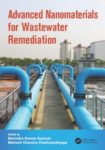
دانلود ایبوک Advanced Nanomaterials for Wastewater Remediation
کتاب زیر در ارشیو گیگاپیپر موجود است. جهت دانلود و خرید کتاب9781498753357, 1498753353 Advanced Nanomaterials for Wastewater Remediation با ما مکاتبه کنید.(my30)
Advanced Nanomaterials for Wastewater Remediation
by Ravindra Kumar Gautam
Publisher: CRC Press
Print ISBN: 9781498753333, 1498753337
eText ISBN: 9781498753357, 1498753353
Copyright year: 2016
فهرست مطالب کتاب Advanced Nanomaterials for Wastewater Remediation
Table of Contents
Foreword
Preface
Acknowledgments
Editors
Contributors
Abbreviations
Chapter 1 Nanomaterials Applications for Environmental Remediation
Anupreet Kaur
Chapter 2 Treatment of Fluoride-Contaminated Water by Electrocoagulation Followed by Microfiltration Technique
D. Ghosh, B. K. Nandi, M. Rahaman, and M. K. Purkait
Chapter 3 Electrooxidation Processes for Dye Degradation and Colored Wastewater Treatment
Farshid Ghanbari and Mahsa Moradi
Chapter 4 Advanced Oxidation Processes Using Nanomaterials
E. Rosales, M. Pazos, and M. A. Sanromán
Chapter 5 Applications of Synthetic Nanocomposite Ion-Exchange Materials as Chemical and Vapor Sensors
Asif Ali Khan, Shakeeba Shaheen, and Nida Alam
Chapter 6 Nanomaterial-Supported Biopolymers for Water Purification
Nalini Sankararamakrishnan
Chapter 7 Nanomaterial-Based Sorbents for the Removal of Heavy Metal Ions from Water
V.K. Garg and Navish Kataria
Chapter 8 Synthesis, Properties, and Applications of Carbon Nanotubes in Water and Wastewater Treatment
Geoffrey S. Simate and Lubinda F. Walubita
Chapter 9 Carbon- and Graphene-Based Nanocomposites for Wastewater Treatment
R. Boopathy
Chapter 10 Nanoscale Layered Double Hydroxides for Wastewater Remediation: Recent Advances and Perspectives
Sushmita Banerjee and Ravindra Kumar Gautam
Chapter 11 Activated Carbon-Doped Magnetic Nanoparticles for Wastewater Treatment
Muhammad Abbas Ahmad Zaini, Lee Lin Zhi, and Tang Shu Hui
Chapter 12 Functionalized Fe3O4 Nanoparticles for the Removal and Remediation of Heavy Metals in Wastewater
A. Sivaraman, D. Manjula Dhevi, A. Anand Prabu, Kap Jin Kim
Chapter 13 Nanoscale Materials for the Removal of Arsenic from Wastewater
Sushmita Banerjee, Puja Rai, Vandani Rawat, and Ravindra Kumar Gautam
Chapter 14 Metal Organic Framework-Based Adsorbents in Water Treatment
Heecheul Kim, D. Manjula Dhevi, Kap Jin Kim, A. Anand Prabu, and Xubiao Luo
Chapter 15 Environmental Fate and Ecotoxicity of Engineered Nanoparticles: Current Trends and Future Perspective
Anamika Kushwaha, Radha Rani, and Vishnu Agarwal
Features
Highlights the potential applications of nanomaterials for the remediation of pollutants from aqueous solutions.
Brings together advanced knowledge on synthesis of low-cost economically viable nanomaterials for water remediation
Describes the impacts of nanomaterials on the living flora and fauna
Explains in detail recent advances in use of nanotechnology for water remediation
Explores ways to perform extensive recycling and reuse of superparamagnetic nanoparticles
Identifies priorities for innovative research activities and possible interactions of nanoparticles with living organisms (plants and animal biota)
Summary
Contamination of aqueous environments by hazardous chemical compounds is the direct cause of the decline of safe clean water supply throughout the globe. The use of unconventional water sources such as treated wastewater will be a new norm. Emerging nanotechnological innovations have great potential for wastewater remediation processes. Applications that use smart nanomaterials of inorganic and organic origin improve treatment efficiency and lower energy requirements. This book describes the synthesis, fabrication, and application of advanced nanomaterials in water treatment processes; their adsorption, transformation into low toxic forms, or degradation phenomena, and the adsorption and separation of hazardous dyes, organic pollutants, heavy metals and metalloids from aqueous solutions. It explains the use of different categories of nanomaterials for various pollutants and enhances understanding of nanotechnology-based water remediation to make it less toxic and reusable.



